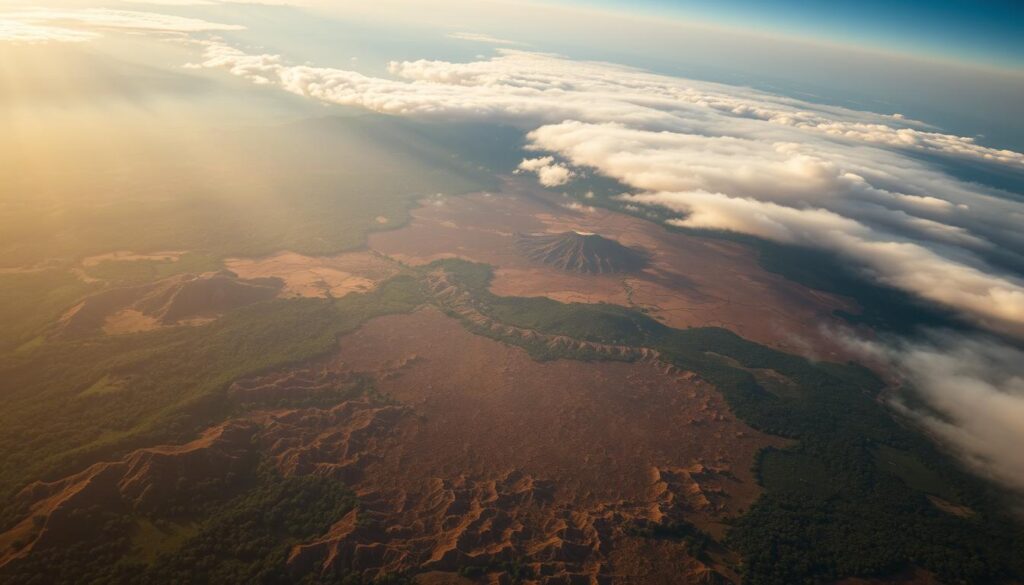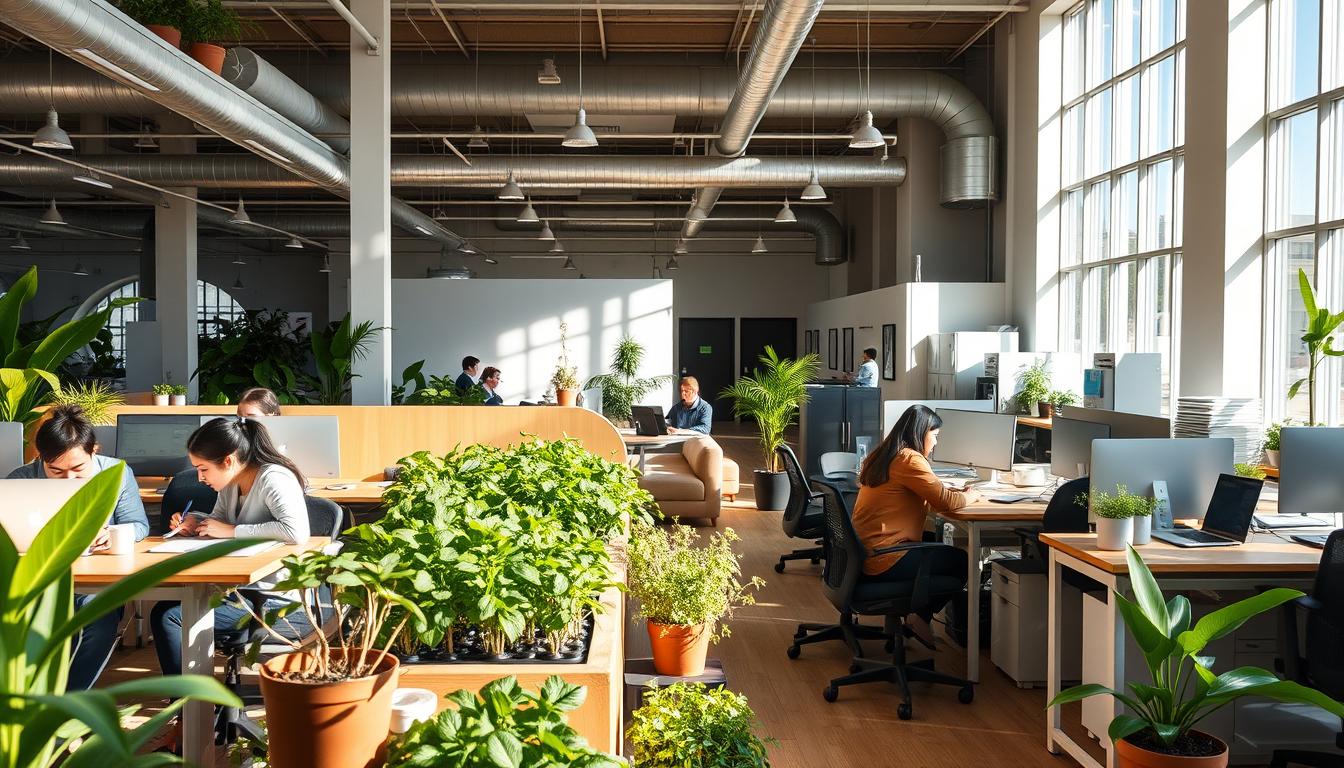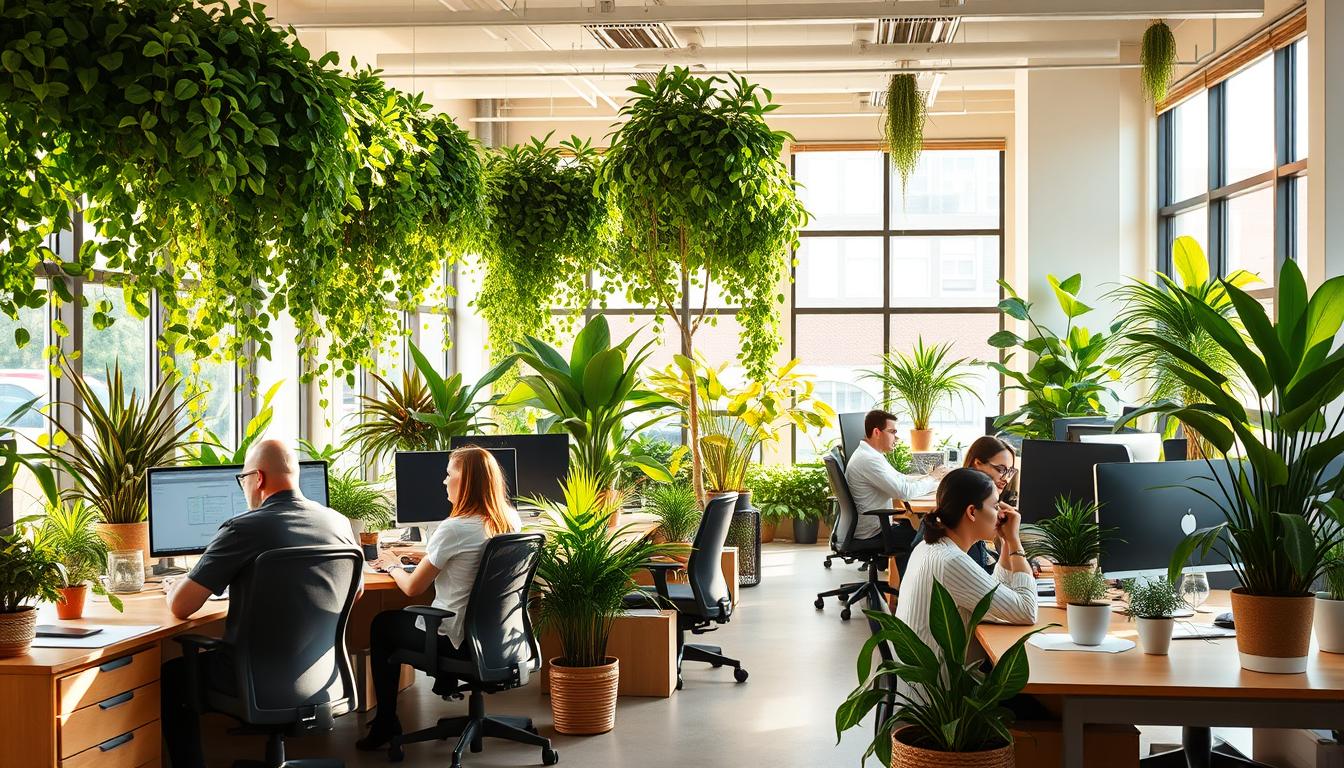As the world faces climate change, it’s clear plants are key for fighting its impacts. They greatly improve our environment in many ways. From making air and soil better to capturing carbon, plants help create strong ecosystems. In this article, we discuss how plants can help us battle climate change and promote a healthy planet.
Understanding Climate Change and Its Effects
Climate change means big changes in our planet’s temperatures and weather over time. It mainly comes from human actions like burning fossil fuels. These activities make more greenhouse gases, which warm our planet. This warming causes serious and worrying changes.
Climate change shows up as hotter temperatures, more extreme storms, and higher sea levels. Around the world, weather patterns are shifting. This leads to long dry spells in some places and heavy rains in others. A 2-degree Celsius rise in temperature makes natural disasters worse and changes ecosystems. This endangers animals, plants, and people’s health.
Wildlife and their homes are also affected as animals try to adapt to changing conditions. It’s important to understand climate change’s effects. This helps us see how projects, especially those related to plants, can help fight these problems. By knowing more about climate change, we can see why it’s vital to live in ways that protect our planet.

Role of Plants in Carbon Sequestration
Plants are key in fighting climate change by capturing carbon. They take in carbon dioxide and turn it into energy through photosynthesis. This process lowers greenhouse gases and makes oxygen, which we need to live.
Photosynthesis: How Plants Absorb Carbon Dioxide
Plants transform CO2 and water into glucose and oxygen using sunlight. This makes them important in reducing carbon in the air. A single tree can take in about half a ton of CO2 a year. This helps a lot in managing carbon and is a big part of the carbon cycle.
Mature Trees: A Significant Carbon Sink
Mature trees store lots of carbon. Forests full of big trees are the biggest land carbon storages. They counteract around 16% of the U.S.’s greenhouse gas emissions. Big, old trees are really good at storing carbon, playing a huge role in battling climate change.
Temperature Fluctuation Buffering with Plants
Temperature buffering is key for keeping ecosystems stable. As our world’s weather changes and gets less predictable, we need natural ways to control temperatures more than ever. Plants play a big part in this. They create small areas with just the right conditions for many life forms. This makes ecosystems more resilient.
Why Buffering is Essential for Ecosystems
Keeping temperatures stable is crucial for ecosystems’ health. When temperatures swing too much, it’s hard on plants and animals. This can change which species live there and affect biodiversity. If there are lots of plants, they can make these areas more stable. This helps protect species that are sensitive to weather changes. It makes places where various species can live well, keeping the ecosystem strong.
Plant Strategies to Mitigate Temperature Extremes
Plants have ways to deal with extreme temperatures. Some main strategies include:
- Shade Creation: Trees and shrubs make shade, keeping the ground cooler when it’s hot.
- Transpiration: Plants release moisture into the air through transpiration. This cools down their area, making temperatures more stable.
- Soil Cover: Ground cover plants and mulch keep the soil insulated. This protects the roots from big temperature changes.
- Diverse Plant Communities: Having different kinds of plants means different ways to handle temperature changes. So, even if the weather changes, some plants will still do well.
Benefits of Urban Forestry and Green Spaces
Urban forestry brings lots of good things, especially better air and more green spots in busy areas. Adding trees and parks in cities makes life better for everyone who lives there.
Enhancing Air Quality in Urban Areas
Trees play a big part in cleaning the air. They take in bad stuff like carbon dioxide and dust. This makes the air healthier to breathe. People then face fewer breathing problems and feel healthier.
Urban Parks as Biodiversity Hotspots
Urban parks are also important for wildlife. They give animals and plants a place to live in the city. This helps keep local nature thriving and improves our quality of life. Urban trees help make our cities livelier and greener places to be.
The Role of Wetlands in Climate Mitigation
Wetlands are key to fighting climate change because they store a lot of carbon. These special places are great at keeping carbon locked away. This helps decrease carbon dioxide in the air. Wetlands are among the best ecosystems at capturing carbon, aiding in the battle against climate change.
Wetlands’ Capacity to Store Carbon
Wetlands store carbon thanks to the plant material in their soggy soils. This process lowers greenhouse gas emissions and makes wetlands stronger. Plants like grasses soak up carbon dioxide, which then gets stored in plants and soil. This natural storage is crucial for facing climate change. It works alongside other environmental efforts.
Natural Water Filtration Systems
Wetlands clean water naturally which helps both water quality and wildlife. They remove harmful pollutants and sediments. This makes the ecosystem healthier and supports many kinds of animals. Wetlands are important for keeping things balanced in nature. They also support life in water. As climate change gets worse, saving wetlands is more important.
Agroecology and Sustainable Agriculture
Agroecology uses nature’s ways to make farming better for the planet. This approach involves using eco-friendly methods to boost food production. It’s about improving the soil, protecting biodiversity, and getting better crops without harming the environment. Farmers who decide to go this route help create a stronger ecosystem. They also help fight against climate change.
Practicing Eco-Friendly Farming Techniques
To achieve sustainable agriculture, it’s key to use eco-friendly farming methods. Here are some effective techniques:
- Crop rotation, which prevents soil nutrient depletion and controls pests.
- Intercropping that enhances biodiversity and improves resilience against climate stresses.
- Organic farming, avoiding synthetic fertilizers and pesticides to maintain ecological balance.
- Cover cropping aims to protect and enrich the soil between growing seasons.
Crop Diversification and Soil Health
Diversifying crops is central to agroecology. It notably improves soil health and farm productivity. By growing different crops, farmers can:
- Enhance soil structure and nutrient availability.
- Reduce dependency on chemical inputs, minimizing environmental harm.
- Combat pests and diseases naturally through biological diversity.
- Increase resilience to climate vulnerabilities by spreading risk across multiple crops.
Reforestation and Its Impact on Climate Change
Reforestation is a key tactic in battling climate change. It allows communities to mend ecosystems that are damaged. The benefits of reforestation go beyond adding trees; they boost biodiversity and air quality too. Adding trees is crucial for tackling climate change, as they capture carbon dioxide from the air.
The Significance of Planting Trees
Adding trees is vital for fighting climate change. They soak up carbon dioxide, cutting down greenhouse gases. Their shade cools the area and they also improve soil by stopping erosion and keeping nutrients. This shows why it’s important to join reforestation efforts.
Success Stories in Reforestation Efforts
Many successful reforestation projects have made a big difference in fighting climate change. Some notable ones are:
- The Bonn Challenge, aiming to restore 150 million hectares of deforested and degraded land globally.
- The Great Green Wall initiative in Africa, which focuses on creating a mosaic of green landscapes across the continent.
- Local community efforts in Costa Rica have led to a notable increase in forest cover, contributing to biodiversity and carbon sequestration.
These stories show how powerful reforestation can be, inspiring more actions for a green future.
Native Plant Landscaping: A Smart Choice
Choosing native plants for landscaping helps both local ecosystems and cities. These plants are right at home in their own climate and soil. This means they are tough and don’t need much from us. Using native plants makes landscaping better for nature and helps fight against pesky invasive species.
Benefits of Native Plants Over Invasive Species
Native plants are the best pick for your garden. Here’s why:
- They’re used to local weather, so they need less water.
- They can fight off pests without chemicals.
- They make the area alive with different plants and animals.
- They keep the soil in place, which helps plants grow well.
- They don’t need much care, saving you time and effort.
Creating Resilient Urban Gardens
Gardens full of native plants do a lot of good in cities. Here’s what they offer:
- They make the air cleaner and places nicer, which makes us feel better.
- They give homes to bees and other helpers in nature.
- They get people together to learn about gardening.
- They keep cities cooler during hot times.
Community Involvement in Planting Initiatives
When local communities get involved, reforestation efforts get a big boost. People planting trees together helps them feel connected to the environment. This feeling makes community bonds stronger and helps everyone understand why saving local ecosystems is key.
Engaging Local Communities in Reforestation
Getting locals excited about helping the environment is crucial. When they plant trees, they work together and help fix natural areas. They get many benefits, like:
- Growing community unity and cooperation
- Enhancing local biodiversity
- Creating green spaces
Educational Programs on Planting and Care
Educational programs keep community members involved over time. They learn how to take care of trees properly. Important parts of these programs are:
- Workshops that teach effective planting techniques
- Discussions on the ecological benefits of trees
- Hands-on activities to promote caring for young plants
Environmental Policies Supporting Plants
To fight climate change effectively, we need strong environmental laws. These laws are vital for encouraging the planting of trees and protecting forests. Across the world, governments are creating plans that focus on these goals. Such efforts are important because they help trap carbon and boost the variety of life.
Government Initiatives for Tree Planting
Many government agencies are making tree planting a big part of their plans to address climate change. They often include:
- Incentives for local communities to engage in reforestation projects.
- Funding programs aimed at enhancing government support for forests through grants and subsidies.
- Collaborations with non-profit organizations to amplify educational outreach regarding tree planting efforts.
International Efforts towards Forest Conservation
Countries around the world are coming together to focus on forest conservation with strong environmental laws. This global teamwork usually results in:
- Joint agreements for sustainable forest management practices.
- Shared resources for research and innovation in tree planting policies.
- Promotion of transnational conservation programs to safeguard biodiversity.
Innovative Solutions for Climate Resilience
Advancements in environmental technology have sparked the creation of new plant solutions. These solutions boost climate resilience. Through biotechnology and genetic engineering, scientists are designing strong plant species. These species can resist the harsh effects of climate change. This work helps protect our food supply and encourages a diverse ecosystem.
Technological Advances in Plant-based Solutions
Recent tech breakthroughs have led to cutting-edge plant solutions for a healthier planet. By using CRISPR gene editing, experts can change plant DNA. This lets plants survive harsh conditions. This method cuts the need for harmful chemicals and makes crops tougher against pests and diseases. These advances are changing farming into a more sustainable practice.
Research on Climate-adaptive Plant Varieties
Researchers are busy creating plants that can withstand extreme weather. They’re finding ways to build in traits like drought survival and flood resistance. These breakthroughs do more than just ensure we have enough to eat. They also help keep our ecosystems healthy and balanced. It shows how farming and technology work together for a better world.
Challenges Facing Plant Ecosystems Today
Plant ecosystems are under threat from several fronts. Invasive species and pests are big problems. They upset the natural balance and cause a loss in biodiversity. Climate change makes these problems even worse. It changes habitats and environmental conditions.
Impact of Invasive Species and Pests
Invasive species become an issue when non-native plants and animals push out local ones for resources. They mess up food webs and take away homes from native wildlife. Besides, pests like insects and diseases destroy plant populations. This brings native species closer to extinction.
Climate Change Effects on Plant Diversity
Climate change is changing the way our planet works by messing with temperature and rain patterns. This can make plant areas bigger or smaller, which hurts ecosystems. As places change, native plants find it hard to keep up. This leads to more loss of diverse plant life. We need to take action now to fight these growing threats. Managing invasive species well is key.
Conclusion
Plants play a key role in fighting climate change. They help our ecosystems stay strong. By doing things like planting more trees and using better farming methods, we make the most of what plants offer. This helps to keep our world diverse and healthy.
It’s also important that communities get involved. When people come together to help plants, it makes a big difference. By joining in on tree planting and learning more, everyone helps. This way, we all take part in reaching our climate targets.
The fate of plant ecosystems depends on us. Acknowledging how important plants are and acting to protect them is crucial. Doing this will help us stand strong against climate change. It ensures a healthy world for future generations.



